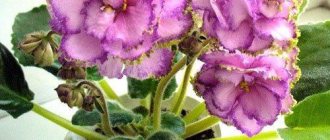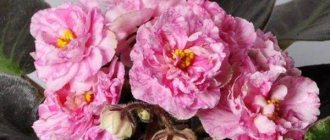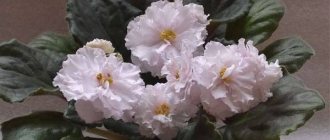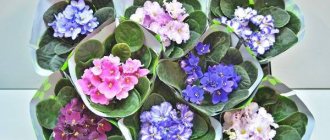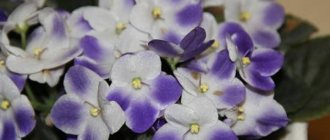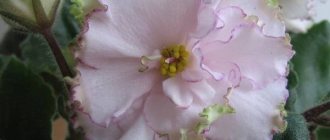Violet, description and photo LE-Southern Night (E. Lebetskaya)
Violets from breeders of the CIS countries - “E,Yu” (LE).
LE-Southern Night (E. Lebetskaya).
LE-South Night, LE-Yuzhnaya Noch' (E. Lebetskaya).
Dark blue simple stars with thin white edging and bright crimson fantasy polka dots.
Variegated dark green and pink even rosette. The leaves are very large and curl inward with a spoon. Standard. The rosette is very large, flat, even, neat. This variety tends to show its adult diameter when young, growing long-petioled leaves for the lower tier. Subsequent leaves will be shorter and will eventually cover all the “holes”.
The variety tends to stretch cuttings, so you will have to play with the light here. When there is insufficient lighting, the petioles are stretched and the rosette becomes loose. In very bright light, the leaves begin to hug the pot.
On different rosettes, the flowers are slightly different in color: on one the flowers are more red (large fantasy spots), on the other the flowers are more purple (there are smaller peas). From flowering to flowering, the pattern on the flowers always changes slightly. And the color is not blue after all, but rather dark purple.
This variety has very interesting flowering. Over time, as the flower matures, the pink fantasy on the flowers becomes closer to red and blurs in the center. A beautiful splash of red from the center of the flower. It seems that the flower is red with blue splashes. As the flower ages, it fades a little. The white edging is more present in the description than in life.
The flowers last quite a long time. It’s in no hurry to grow leaves, it’s constantly chasing buds, it doesn’t want to grow foliage, it wants to bloom. The peduncles are tall, do not lie, but look in different directions.
The variety is unpretentious, the leaves take root well and produce a lot of children, it grows quickly. Transmission of color when propagated by leaves is good. He is building up a lot of stepsons. Sports bloom in monochromatic colors.
Do you know that…?
The most variegated are the mature leaves. Spectacular variegation is most often a characteristic of the variety. At different stages, rosettes may have different variegation. Young rosettes have very spectacular variegated foliage, while older rosettes have normal variegation. Variegated violets are more difficult to grow than violets with solid green leaves. This is the reason why plants with variegated leaves grow slower and are more sensitive to growing conditions, diseases and stress. Moreover, the brighter the variegation, the more problems. It is difficult to achieve abundant flowering in the most variegated ones, and after flowering they rest longer. You also have to wait quite a long time for the first flowering; only a well-developed rosette produces flower stalks.
Before you buy the violets listed below, carefully read the forums about their behavior on the windowsill. Many of them are very beautiful flowers. However, these can be large rosettes with large and fragile leaves, with leaves rising up or hugging the pot, forming many stepsons that interfere with the formation of a neat rosette, pulling the stem up and growing into a Christmas tree, bending the trunk, rare flowering with long breaks, fallen flowers or they last little and quickly wither, very long and recumbent peduncles, the color of the flower fades quickly, they do not like bright lighting on the windowsill, they are afraid of the slightest drying out or waterlogging, a large percentage of them go into sports or darken the flower.
Are they suitable for your window sill and the conditions that you can create for them? You will look at the flowers for several months, and the rosette will always be in front of your eyes. There are many beautiful flowers, there are much fewer beautiful and neat rosettes, look first at the rosette! Search and you may find a dozen violets with the same flower color if you are not interested in the smallest details as a collector.
•— Exclusive (Korshunova); •— Emmanuel (Prilutskaya); •— Esther (Lebetskaya);
•— Julia (Lebetskaya); •— Young Spring (Lebetskaya); •— Young Witch (Korshunova); •— Juno (Pugacheva); •— Jupiter (Makuni);
•—Apples (Lebetskaya); •— Java Moss (Violet Plant); •— Japanese Spring (Sergeeva); •— Yaroslavl (Korshunova);
Southern night violet: cultivation
Violet Southern Night: photo
In order for the LE Southern Night violet to bloom regularly and luxuriantly, you should create comfortable conditions for the plant; this rule applies to any, even the most unpretentious plant.
When choosing a flower pot for a violet, you should give preference to small containers, since a violet growing in a large pot will direct all its efforts to growing the root system, and this will happen to the detriment of flowering. For an adult plant, the most optimal would be a flower pot with a height of 10 cm and a diameter of 11-13 cm. There are no clear recommendations regarding the material from which the container is made, as there are so many flower growers, so many opinions. Some people prefer to grow violets in plastic containers, while others prefer exclusively ceramic flower pots.
If we consider this issue from the point of view of environmental friendliness, then, of course, a breathable ceramic container is the best option for any indoor plant, perhaps with the exception of orchids, which feel more comfortable in plastic pots.
The second important factor on the path to success will be suitable soil for violets. Nowadays in large flower shops you can purchase specially prepared soil for almost any plant, including Saintpaulias. Before planting, it is recommended to carry out preventive treatment and spill the soil with a solution of potassium permanganate or calcine it in the oven to ensure that all pathogenic bacteria are destroyed, and then add fine expanded clay or vermiculite to the soil to achieve the best looseness and moisture permeability. As is the case with any indoor plants, before planting violets, be sure to place a layer of drainage material on the bottom of the flower pot, which will prevent stagnation of water in the soil.
Violets need a lot of light to thrive and bloom; this factor must be taken into account when choosing a location for the plant.
But it is important to remember that direct rays of the sun will be destructive and will leave burns on delicate leaves, so you can place a violet on the windowsill only if the windows of your apartment face the north, east or west side, or if tall trees grow in front of the window that scatter light. In winter, it is better to remove the violet from the windowsill so that it does not suffer from the cold.
Violets of the Southern Night variety do not require a cool rest period; the optimal room temperature throughout the year is from +18 to +22 degrees.
The Southern Night violet loves moist air, but, like other violets, it is not recommended to spray it with a spray bottle. To humidify the air, you can place a container of water next to the plants, gradually evaporating, it will humidify the air. Some gardeners recommend that in the warm season, once a month, give the violet a short warm shower, after which you should definitely blot the leaves with a soft cloth to remove any remaining moisture. It is believed that this procedure improves the decorative qualities of the plant. But since this contradicts the recommendations for spraying, each grower determines the need for this procedure himself.
Distinctive features
Lebetskaya varieties are distinguished by abundant flowering in the early stages. Breeder's violets with graceful compact rosettes surrounded by emerald green or variegated foliage.
IMPORTANT: When choosing a flower for propagation, you need to carefully study the rules for caring for the species you like. It wouldn’t hurt to visit a couple of forums dedicated to Saintpaulia lovers, ask amateur flower growers, and read specialized literature. Our specialists have prepared for you a number of materials that contain information about the most talented breeders and the varieties they have bred. Read about the violets of Natalia Puminova, Konstantin Morev, Tatyana Pugacheva, Alexey Tarasov, Evgeny Arkhipov, Boris and Tatyana Makuni, Natalia Skornyakova, Svetlana Repkina, Tatyana Dadoyan and Elena Korshunova
Read about the violets of Natalia Puminova, Konstantin Morev, Tatyana Pugacheva, Alexey Tarasov, Evgeny Arkhipov, Boris and Tatyana Makuni, Natalia Skornyakova, Svetlana Repkina, Tatyana Dadoyan and Elena Korshunova.
Description of the variety
The “Southern Night” violet was bred by a breeder from Vinnitsa, Ukraine, Elena Lyuberetskaya.
Her gradual fascination with violets turned into collecting, and then into a passion for selection. The number of violet varieties bred by Elena to date is more than 250 varieties.
This variety belongs to the fantasy violets, which are characterized by randomly located spots or dots on the petals. The flowers themselves are dark blue with a thin white edge. Fantasy peas on bright crimson petals.
Leaves
The flower is not inclined to grow large foliage; it prefers flowering. This variety tries to pull the leaves up, so they will not hug the pot. The rosette of the flower is very large and has a flat, neat shape.
Flowers
It is interesting to observe how the color of the bud changes during the flowering process: the pink fantasy eventually blurs in the center and turns red.
Then the richness of the color “goes away”. Flowers on different rosettes will differ in color: some are redder, others are purple, and the size of pink peas is also different.
Features and differences from other varieties
Violet "Southern Night" is an unpretentious variety. What violet lovers value - long flowering coupled with successful reproduction - guaranteed this beauty a permanent residence on the windowsills of houses and apartments.
Violet Southern night: care
Violet Southern Night: photo
You can replant an adult violet LE-Yuzhnaya Noch less often than many other varieties. Instead of an annual transplant, it will be enough to carry out this procedure once every 2 or 3 years. During the replanting process, try to remove most of the old soil from the roots as carefully as possible; you can also cut off some of the roots (just do this with a sharp and sterile instrument). And replanting should be done before or after flowering.
During flowering, the Southern Night violet must be fertilized regularly using a special fertilizer for Saintpaulias. Feeding is carried out every two weeks. During the dormant period, the plant does not need a large amount of nutrients, so it will be enough to feed it once every 5-6 weeks. Never fertilize plants with concentrate; be sure to dilute it in water for irrigation, strictly following the instructions.
Well, the most important part of caring for the Southern Night violet, which determines its well-being, is watering. The water should first be settled and, if necessary, heated slightly (to room temperature)
To prevent moisture from getting on the leaves and peduncles, violets should be watered through a tray. Within 30-40 minutes, the plant will absorb as much moisture as it needs, and the remainder should be drained to prevent waterlogging of the soil.
violet violet
Saintpaulia (violet) is native to Africa. This plant will help improve communication with colleagues and avoid conflicts. And according to the teachings of Feng Shui, modest violets are even capable of luring wealth into the house. Violets with different flower colors have different energy. White violets are an excellent cure for stress and overwork, and relieve negative emotions. Plants with purple flowers can awaken spiritual strength and intuition, but they also remove a person from worldly vanity. Violets with blue flowers support creative and active people, encouraging them to fully reveal their talents. Red or pink violets - they develop optimism in life, and also help to maintain a diet, so it will be appropriate in the child’s room, and at your desk, and even in the kitchen. Violets love the company of their own kind, and they show their energetic properties after some time, when they get used to their owners.
| Product added to |
| Cart |
Content Features
All violets love light; for full development and flowering, the daylight hours should be at least 10 hours. The plant should be placed on a windowsill or on a table near the window, turning the pot with the plant around its axis so that the leaves evenly stretch towards the light source. But violet leaves can get burned from direct sunlight. The plant does not tolerate drafts.
Watering
Violet is capricious when it comes to watering: it equally dislikes waterlogging and drying out, so you need to do this in a timely manner - about 2 times a week.
Water should be poured into the pan and after 20 minutes the remaining liquid should be drained so as not to damage the roots. Watering from above has a detrimental effect on the plant: drops of water on the leaves and growing point can destroy a healthy plant.
Fertilizer
Complex fertilizers are used - this will ensure ideal cultivation. They mainly consist of phosphorus and potassium, as well as nitrogen
It is important to maintain the correct proportions, since nitrogen promotes the development of leaves, but in excess it slows down flowering, and phosphorus, on the contrary. Potassium is necessary for leaves to be elastic and also speeds up flowering
It is important to know that fertilizing is prohibited after replanting for a month, in frosts and extreme heat, during a flower illness, and also if the flower is exposed to direct sunlight. Fertilizing is done once every 1.5-2 weeks with a special fertilizer (if this fertilizer is not for violets, but in principle for flowers, the concentration is halved compared to the instructions)
Fertilizing is done once every 1.5-2 weeks with a special fertilizer (if this fertilizer is not for violets, but in principle for flowers, the concentration is halved compared to the instructions).
Transfer
Careful transshipment every spring. Tight pot, good drainage. Soil: leaf, peat soil and sand / vermiculite or ready-made soil 'for violets'
Diseases and pests
Indoor Saintpaulias often suffer from powdery mildew. Treatment for powdery mildew is easy and simple - the violet is sprayed once with a substance such as benlate or fundozol.
Root rotting. The causes of the disease are too high soil moisture when it is watered very often with cold water, especially if Saintpaulia is located in cold or cool conditions. When the plant withers and even rots, you need to use the substance phytosporin.
Fusarium is the rotting of the rosette, and it is caused by improper care.
Scaleworms. Means that should be used to treat violets to remove scale insects: Aktara; Aktellik; Fitoverm.
Aphids can be brought indoors with cut flowers in the garden. It will attack flowers, violet stalks and buds. These pests feed on their juice. Plant growth will be poor, the petals will become deformed and wither. Mospilan and Actellik are good drugs for controlling aphids.
Ticks. Treatment is carried out with such means as Fitoverm, Akarin and Actellik.
Growing process
Saintpaulia lovers are often divided into two camps. The first believe that growing it is easy and pleasant. They claim that it does not take much time. The latter call this process very troublesome, and the violet itself – very capricious. In fact, in order not to destroy the plant, it is enough to adhere to a few basic rules for growing and caring for the African guest.
Container and soil
You should not pay too much attention to the quality of the container or pot. "Dandy" grows well both in a plastic bucket and in a ceramic bowl
The main thing is that the container has holes at the bottom and stands in a shallow saucer. It is convenient to keep small shoots in special violet “nurseries”, which are a small rack with many small pots. For an adult flower, a container with a diameter of 10 cm and the same depth is sufficient.
As for the soil, its preparation will also not take too much time. You can simply take a small amount of soil from any deciduous forest. Anyone who prefers to purchase soil in a store can choose a special composition, which includes:
- turf;
- humus;
- sand;
- sphagnum moss.
Lighting
The “Dandy” violet, accustomed to heat, requires a lot of light even in home conditions. The growth rate and duration of violet flowering depend on the illumination. There is only one way to ensure this under the roof of a house or apartment - placing a flower on the windowsill. However, there are some nuances here too.
- It is better to choose an eastern or western window so that the light is diffused, otherwise it will easily burn the delicate leaves and petals.
- If all the windows of the apartment face south, the glass should be slightly shaded.
- The kitchen is the best room for “Dandy”, as it is always warm due to the preparation of dishes and the operation of appliances.
- A signal about an excess of direct sunlight will be withering and losing color leaves, which will begin to stretch upward, disrupting the rosette.
Humidity
The main condition for the growth and development of violets is timely and proper watering. The procedure depends primarily on the time of year. So, in summer the plant should be watered 1-2 times a week, depending on the weather outside. In winter, it is better to limit watering, adding water as the soil in the pot dries out.
There are several ways to properly water Saintpaulia.
- Above. In this case, you need to use a watering can or teapot with a narrow spout and pour water onto the ground, under the roots of the plant.
- From below. With this type of watering, water is poured into the lower saucer-stand in which the pot stands. The plant itself will absorb the amount of water it needs in 20-30 minutes. After half an hour, the remaining water in the saucer is simply poured into the sink. If you leave it, the roots of the violet will begin to rot, and soon the flower will die.
It is better to remove excess moisture, which parts of the violet do not have time to absorb during the procedure, with ordinary paper napkins. Drops of water remaining on the trunk and leaves of Saintpaulia will serve as strong lenses for sunlight and leave burns on the velvety skin. The humidity of the room itself should also be considerable, so you can place a container of water next to the flower pot. As the liquid dries, it needs to be added.
Top dressing
In spring and summer, violets require the application of mineral fertilizers with phosphorus and potassium. They promote the appearance of fresh buds and color the flowers a brighter pink color. During the growth of young violets, nitrogen fertilizing can be applied to the soil; it promotes the development of the flower. In these cases, it is best to use ready-made liquid preparations, which are sold at any gardening store. Two hours before feeding, you need to water abundantly so that the chemicals do not burn the small roots.
It is always better to slightly underfeed African Saintpaulia than to overfeed it. If the plant looks healthy on the outside, it is better not to add anything to it at all. In case of an overabundance of minerals, flowering may not occur or may be significantly delayed.
How to grow violets at home
Ampelous
Ampelous violets are intended for growing in flowerpots and hanging pots. They decorate both balconies or loggias, and hanging flower beds. Plants have several growth points. A high number of new shoots are formed on the sides. Long stems point downwards. They need good lighting. They bloom throughout the year. In winter, the plant needs additional lighting.
Lituanica
An ampelous variety with large, densely double inflorescences. The petals are slightly elongated, similar in shape to small dahlias. The color of the flowers is pink-peach. The edge of the petal is painted in a more intense color. The leaves are densely pubescent, dark green, pointed at the end. The stem is elongated. The rosette is tall, well leafy, growing to impressive sizes.
Grinya
This is a slow growing violet hybrid. The flowers are large, semi- and densely double. At the bud stage, the flower is entirely green. As it blooms, it enlarges and turns white. A wide green border remains along the edge of the corrugated petals. It disappears over time, after which the flower becomes snow-white. The rosette is sparse and develops evenly. The leaves are wavy, rich green, hanging from the pot. Flowering lasts a long time.
The bride's bouquet
This richly flowering variety has large star-shaped flowers of soft white color. The edges are wavy. Flowers are very similar to a wedding bouquet.
Whipped cream
The flowers of this plant are white, large in size, double, and lacy. The edge of the petal has a thin pink-raspberry ruffled border. The rosette is light and small. The foliage is slightly wavy.
Bridal bouquet
The flowers are snow-white, very large, single or semi-double. The center is bluish. Green corrugated border. The leaves are simple, light green in color. Standard size socket.
Georgia
This is a profusely blooming violet, a very noticeable variety. The flowers are bright pink, double, large in size. The edges are strewn with lilac specks. They are wavy and have a thin light green border. Flowers are formed on powerful, large peduncles. For rich flowering, the variety requires appropriate conditions for maintaining the flower.
Rose of Wind
This delicate and incredibly beautiful violet. The flowers are medium-sized, approximately 4 centimeters in diameter, double, similar to lush garden roses. Petals are white and pink. The edges are broken, corrugated, light or dark pink in color. In some places a green border is visible. The buds are located on a thin stem. The foliage is spreading, light green, forming a rosette. Several double flowers are formed on one peduncle.
Don Juan
This is a variety with large purple-plum single or semi-double flowers. The border is wide, strongly corrugated, bronze-green in color. The foliage is dark green with pink edges, slightly wavy.
Macho
This is a semi-double chameleon variety. The flowers are burgundy-violet, almost black. The buds are densely located. A bright white border is visible along the edge of the petals. In natural light the flower becomes purple, almost black, and when illuminated it turns burgundy. The leaves are green, large, raised, ovoid. There are many flower stalks, they develop and grow unevenly.
What does night violet (matthiola) look like?
Night violet has a scientific name - Lyubka bifolia and belongs to the group of biennial or perennial medicinal plants. It is also called hesperis, matron's nocturnal, wild balsam, cuckoo's tears, haystack, and forest balsam. But many gardeners most often call it matthiola.
This flower has many names
For your information! Today there are about 40 species, most of which are located in the European and Asian parts of Russia, as well as in the Caucasus. It is these regions that are the most favorable in terms of plant growth conditions.
A brief description of what a night violet looks like:
- the plant belongs to the Brassica family and is included in the dicotyledonous class;
- When planted in open ground, it does not produce flowers in the first year. The plant itself reaches a height of 0.5 to 1 m;
- stems slightly hairy;
- leaves are narrow, pointed at the base. Their length is about 12 cm, while the width is only 4 cm;
- flowers are small, 4-petaled. Large ones are observed only in artificially grown ones. The length of the inflorescences reaches 30 cm;
- their shade is usually light, but can range from white to soft lilac or pink.
- There are perennials that can bloom quite unusually compared to the standard night violet flower. There are also hybrids in which not simple flowers predominate, but double ones;
- The significant difference between night violet is that it has a pronounced smell, which is felt not only in the immediate vicinity of the plant, but also fills the adjacent space. It manifests itself especially strongly in the evening after sunset. In this regard, this plant has no analogues among ornamental flowering crops.
The plant will fill the entire garden plot with its aroma
Briefly about the history of appearance
This plant prefers to grow in mixed forests, bushes, forest edges or hills. It mainly grows in single specimens, that is, scattered, does not form crowded plantings.
Its prevalence from Europe to Asia has made the flower popular for growing in flower beds and balconies. This happened due to the wonderful aroma that fills the space. In addition, the appearance of the plant is so elegant, delicate and sophisticated that it is used by landscape designers to decorate areas that claim a natural look.
Note! To date, several hybrids have been bred that are somewhat different in their external characteristics from the standard wild flower.
Common varieties
Night violet is a popular flower that comes in several varieties. Therefore, before planting it in a flowerbed, you need to decide what effect you want to get. To do this, you can use the following flower subspecies:
- purple matron has a bright, pronounced aroma exuded by fairly large flowers. They are collected in cylindrical inflorescences. Planted with seeds in open ground at the end of spring;
- hesperis Inspiration refers to 2-year-olds with simple flowers collected in racemes. The shades of the petals can be varied. The plant itself reaches a height of no more than 1 m. The aroma is lighter and more delicate;
- Romance has white flowers and a soft aroma, exuding only in the evening and at night;
- The crimson matron noctule is the most common species. It has bright crimson flowers, growing chaotically on branched stems;
- Night beauty. Delicate purple shades are collected in large inflorescences. But the shrub is less tall, only 60 cm maximum under favorable growing conditions. Gardeners often prefer this variety because it is frost-hardy and easily resists a variety of diseases and parasites. Used for planting in personal plots and decorating balconies.
The Night Beauty variety easily tolerates winter frosts and does not require shelter.
Planting and propagation
There are several methods of reproduction, two of them are described below.
Propagation by cuttings
Propagating violets from cuttings is a simple process. You need to take a healthy, beautiful leaf from an adult plant from the second row from the bottom and cut it with a sharp knife or blade at an angle. The length of the petiole on the cut leaf should be about 3 cm.
Important! It is not recommended to cut leaves for propagation with scissors! With this method, the capillaries of the stem are pinched. This advice applies to all types of flowers. Place the cut leaf in a small glass of water at room temperature so that only the stem is in the water, but not the leaf itself.
After two weeks, roots can be seen on the cut of the cutting.
Place the cut leaf in a small glass of water at room temperature so that only the stem is in the water, but not the leaf itself. After two weeks, roots will be visible on the cut of the cutting.
Now the cutting can be planted in the ground. Pour thoroughly ground and moistened substrate into a glass with drainage holes.
Then plant the cutting in the prepared place, compact the soil so that the leaf does not wobble. Water the soil again, cover the glass with a transparent container (you can cut a plastic bottle).
Keep an eye on your greenhouse so that condensation does not accumulate in it, otherwise the plant may die.
You can make a small hole at the top of the cap so that excess moisture does not linger inside. When you realize that the leaf has taken root, the greenhouse can be removed.
As the mother leaf develops, “babies” will appear. The speed of their growth depends on the conditions that you create for the plant.
The fewer “babies”, the faster they will grow. It is better to separate them from the mother leaf when the degree of green color is sufficient. This means that the leaves have enough green pigment and are quite strong.
Seeds
Another way to propagate violets is by seeds. The plant will grow much stronger than with cuttings. The color of the flower is also better conveyed.
Growing methods
You can grow a new bush using standard propagation methods:
- By seeds - after dusting, you can get a seed pod and try to raise the babies. This method is labor-intensive and does not guarantee effect; the seeds quickly lose their similarity, which is quite poor even in freshly collected material. To obtain offspring you must:
- Prepare a container: a flat container that can be tightly covered with film or glass is ideal;
- Pour soil, layer thickness 2-3 cm, moisten with a sprayer;
- Sow the seeds, you can sprinkle them with a very thin layer of substrate, but this is not necessary, cover them with glass or film, creating a greenhouse;
- After sprouting, you can open the container, the flowers dive after they become crowded, earlier it is possible, but this is not justified.
- Leaf and peduncle - take a leaf or peduncle from an adult plant and root it:
- The leaf is chosen from the second or third row, it must be healthy and strong; The peduncle needs to be thick, fresh and strong;
- Root in a convenient way: in water, in soil, with wick watering in moss;
- When the baby appears, it is grown on a leaf (peduncle), and then planted.
- Stepson - small children are often formed in the axils of the leaves; they are planted in two ways:
- They wait for roots to form (this happens after the plant is deepened, to the level of the lower part of the stepson), then they are separated from the mother plant and planted in a small pot;
- Separate 4-6 leaves at the stage and root them like a leaf.
Attention! All resulting children, regardless of the method of reproduction, are transplanted into larger flowerpots as they grow. Care is no different from adults.
Perennial garden violet
Unlike the usual pansies that bloom in early spring and disappear into the snow with their flowers, perennial garden violets delight us with abundant and lush flowering only in the spring; in the summer they lose their decorative effect due to the abundance of seed pods. Timely removal of faded flowers will help prolong flowering. Usually, sweet violet and horned violet are grown as perennials.
1. Fragrant violet (Viola odorata) is an unpretentious perennial garden violet, a very fragrant plant about 15 cm tall. The stems are creeping, easily rooted, the heart-shaped leaves are collected in bunches. Flowers about 3 cm can be single or double, usually blue or purple in color. The aroma intensifies in the evening. It is quite difficult to grow from seeds; preliminary stratification is required. Seeds for planting need to be fresh for good germination.
2. Horned violet (Viola cornuta) is a perennial plant about 8-20 cm in height. Flowers of this species are characterized by the presence of a “spur” in the back of the flower, although not all varietal plants have it. The diameter of horned violet flowers is from 1.5 to 3.5 cm, the color is mainly white-yellow-blue, however, modern varieties and varieties are very diverse. Among producers of seeds and seedlings, it is customary to divide horned violet into two product groups - Viola Cornuta and Viola x hybrida (V. hybrida (x cornuta)). The second group has a more complex hybrid origin, being a hybrid of horned violet and other species. Hybrid forms tolerate winter worse; they are often grown as biennials.
Perennial violets in the garden
In the garden, violets are used to decorate flower beds and ridges, borders, and alpine slides. Violets feel good among trees and shrubs, near bodies of water. They make beautiful floral rugs. Suitable for growing in various garden containers, flowerpots and balcony boxes. It is good to plant fragrant violets near recreation areas and in the front garden in front of windows. Violets are suitable for forcing in winter. Various baskets with these amazingly delicate romantic flowers look very beautiful.
Perennial garden violets. Growing
Perennial garden violet prefers sunny or slightly shaded places, rich, moist but well-drained soil. Violets, despite the fact that they are moisture-loving plants, do not tolerate excess moisture and can easily die during spring thaws. Care consists of timely watering and fertilizing with complex mineral fertilizer 2-3 times per season. For the winter it is better to cover with a dry leaf or spruce branches.
Perennial garden violets are propagated by seeds, cuttings or dividing bushes. Seeds are sown in open ground in June or before winter. Violets reproduce well by self-sowing. Violets are permanently planted with a distance between plants of about 30 cm.
In the language of flowers, VIOLET - HUMILITY, DIGNITY, INNOCENCE, SECRET LOVE
Features of the flower
The size of the plant ranges from 0.5 m to 1 m. The bushes are medium spreading, the branches rush upward along with the flower stalks.
Color
The color of the leaves and stems is grayish-green. Sometimes it has a slight bluish pubescence.
The color of the petals varies depending on the variety, but always ranges from white to pale pink, pink to lilac, pale blue to blue. There is also a crimson color.
Flowering time
Mattiol (night violet) is most often found in the garden. There are levkoy and two-horned. The flowers of the two-horned plant are very inconspicuous and small, but they are planted solely to obtain a delicate background and a pleasant smell in the evening.
For your information! The flowers of the two-horned matthiola close while the sun is shining, and after sunset they begin to open and release a fragrance.
But matthiola gillyflower is planted for its decorative appearance. During the daytime, the buds of these flowers are open. Their diameter is quite large, their colors are bright and varied. Petals can be not only simple, but also double, which gives them higher decorative properties. In terms of aroma, this variety is much inferior to the two-horned species.
Additional Information! In any case, flowering lasts about 2 months. Most varieties bloom from mid-June to mid-August. Some fade and are replaced by other buds.
Habitat
Growing matthiola is possible in central Russia and the southern regions, from the European part to Siberia. But these plants feel best in the foothills of the Caucasus and in flat areas.
The progenitor of decorative varieties of night violet is Lyubka bifolia. It is short and most often reaches 30-40 cm in height. Its peculiarity is that it has 2 tubers that are not separated from each other. Every year a new, replacement tuber appears. Two leaves are formed at the base. At the end of the thrown arrow, a brush of colors of pale shades is formed.
Lyubka bifolia
An interesting fact is that this plant is medicinal. For medicinal purposes, tubers are used, which contain glycosides and mucus, as well as starch and sugar. But it is the mucus, which is called salepa, that has a beneficial effect on the gastrointestinal tract, providing an analgesic effect. In addition, the plant is used for poisoning, abscess, inflammation of the bladder, nervous exhaustion, inflammation and non-healing wounds.
Description of the variety
Description of the violet Angelica deserves admiration. The key feature of the variety is its lush double flowers of pale pink color. Along the edges of the petals, 2 contours of different colors appear: white and lilac. As a rule, in its first flowering, only a lilac stripe appears on the violet, but already on the second or third flowering a second color is added. On the main part of the flower there is a soft pink speck. Violet Angelica blooms magnificently, a large number of buds immediately appear on it. The flowers themselves are large in size, and their number increases with increasing flowering.
As for the leaves, they do not differ in double color or unusual pattern on them - a simple, standard shape, smooth, flat surface does not distinguish them from the leaves of other varieties of violets. The leaf color is dark green.
Violet African Night (K. Katkin)
In terms of size, the African can be classified as standard, and some individuals can even be classified as large varieties. Saintpaulia leaves:
- Large;
- Dark green with a reddish underside;
- Prone to impaired horizontal growth;
- And they reach to the top.
The flowers are large and deep dark purple; abundant light can result in blue blooms.
African night original.
This variety was bred in Odessa by breeder K. Katkin. For a long time, it was considered the darkest variety, and this was the reason for its popularity. But the simplicity of the flower and the dimensions of the rosette, after the appearance of darker options, pushed this beauty to the lower positions.
After reproduction, sport flowering is quite often observed. The color usually remains the mother's, only the underside of the petals is slightly lighter.
African night sports.
Attention! Most of these offspring have slightly double flowers, which, as before, are huge in size, but more of them are formed on the peduncle (standard 1-2, sport 3-4).
We'll talk about care and reproduction below.
Description of the variety
As a rule, “Isadora” is a violet of light pink or white shades with more contrasting hot pink, purple or lilac spots.
The violet of this variety belongs to the Gesneriev family - Saintpaulia. The petals of violet buds are fleshy, round in shape and soft - covered with villi.
Story
“LE-Isadora” was bred by breeder from Ukraine Elena Lebetskaya.
This variety, like almost all varieties from this breeder, is a very delicate and graceful flower. Its distinctive features are its fairly large size and a coating on the petals that makes the flowers seem like velvet. Elena Lebetskaya herself described the flowers as semi-double.
Interesting! Single and semi-double white stars with pink prints, studded with fuchsia fantasy touches. Green smooth leaves. (Description by E. Lebetskaya)
Bloom
The bud opens for a long time, remaining in the form of a rose for a long time. Full disclosure occurs in about two weeks.
A green border can be seen on a newly opened bud, which disappears over time.
The flowers are on average 4-5 centimeters in diameter. There are from three to six buds on the peduncle. Despite the fact that the peduncles are short, they do not have a strong build.
Socket
The flowering period is very long. The rosette is standard, medium in size with even stripes of leaves. One of the best types of propagation is cuttings. This method increases the fertility of violets. Being a type of fantasy violet, they can also have sports. To avoid this, it is recommended to bring several rosettes at once before flowering.
Leaves
The leaves are large and may droop when there is plenty of light.
Foliage color varies between medium green and dark green. The type of foliage is simple, heart-shaped, quilted.
The reverse side of the foliage has a pink tint, and the edges of the leaves seem to be slightly torn, as they have jagged edges. Variegation is not typical for this variety.
Interesting! Since the variety is fantasy, this variety may have sports.
Violet RS-Princess Olga
Indoor violet RS-Princess Olga belongs to the genus of hybrid Saintpaulias, from the Gesneriev family. This variety was bred in our time by breeder S. Repkina, as evidenced by the prefix RS at the beginning of the name.
Violet RS-Princess Olga.
The rosette is large, even huge, in 9 it grows up to 45-50 cm. Sheets:
- Large;
- Slightly quilted;
- Dark green color.
You can see a photo of the violet RS-Princess Olga above.
There are few teeth along the edge of the leaf, and the shape is slightly heart-shaped, with thick, medium-sized stalks. The rosette forms itself and does not require much light.
The flowers are large, simple stars, slightly wavy along the edge, the first ones are up to 8 cm, and then they become slightly smaller, but the minimum is 6.5 cm. The color of the flowers is composed of two colors:
- Basic white;
- Complete with bright fuchsia prints that sometimes take up most of the petal.
Flowering depends on temperature and ranges from white petals with a chimera-like stripe to fuchsia with a white edge.
Sports are rare for this variety, but sometimes you come across children with a purely fuchsia flower or with a chimeric color.
Attention! Sometimes a chimeric flowering resulting from care or failure is specially propagated by a peduncle to produce a chimeric baby, but this does not always work out.
Features of flowering, growth and reproduction
At home, the variety grows very well and does not require additional light, while the rosette forms perfectly. A mature rosette can be grown in 11-12 months and blooms earlier, but the first bloom does not produce full size flowers.
This variety is propagated in any of the convenient ways:
- Sheets;
- Stepchildren;
- Peduncles (especially for securing special flowering, for example, chimera).
The variety is quite prolific, produces 2-4 children per leaf, and is often divided by stepsons.
The variety blooms profusely - in a bouquet, large flowers cover the rosette almost completely, but their shape and size do not allow calling this flowering cap. Peduncles:
- Middle length;
- Sturdy;
- They carry 2-4 buds.
Flowering lasts a long time, and each flower lasts up to a week. The color varies greatly depending on the temperature, the hotter it is, the darker the flowers - in a cool room it can bloom like a chimera, with a rather thin fuchsia stripe, but in the heat the white part almost disappears, leaving a thin border around the edge.
Possible problems in growing
There may be some difficulties when raising a Blue Dragon. Most often this occurs as a result of a decrease in the plant’s immunity due to non-compliance with care requirements.
Problems with leaves
When buds are forming, the edges of the Blue Dragon's leaf blades can curl down, and during flowering they are completely leveled. This is a feature of the variety. There is no need to do anything.
Sometimes brown spots appear on the leaves. This may be due to improper watering or spraying, resulting in moisture remaining on the leaves. Direct sunlight, which burns the violet leaves, can also provoke such a defect.
Brown spots on the leaves are a sign of improper care
Pests
Saintpaulia may suffer from spider mites and mealybugs. When attacked by pests, the rosette slows down its growth, the plant looks depressed, and young leaves become deformed.
To control pests, it is necessary to spray the violet with preparations such as Fitoverm or Actellik. The treatment is repeated every week until plant growth resumes.
Diseases
The Blue Dragon variety is susceptible to powdery mildew and gray rot. The provoking factor for the development of diseases is stagnation of moisture in combination with cool conditions. The following drugs are used for treatment:
- "Topaz";
- "Skor";
- "Fitosporin".
Signs of improper care
When growing Saintpaulias, it is important to monitor the condition of the plants and promptly respond to any negative changes. Main signs of improper care:
Main signs of improper care:
- slow growth;
- small colorless flowers;
- deformed sheet plates;
- short flowering period or its absence;
- dried tips of leaves.
Caring for Saintpaulia Blue Dragon is slightly different from other species. This variety is more demanding and does not forgive the gardener’s mistakes. In order for the flower to be healthy and delightful with flowering, when growing it, you must carefully follow the rules of care.
Conditions of detention
The intensity of violet flowering depends on the characteristics of the environment in which it is kept. First you need to buy a special substrate, which is a light mixture rich in useful substances. Some gardeners advise mixing such a substrate with regular soil, previously calcined in the oven, in order to disinfect it and so that moisture is better retained in the ground. Drainage must be placed at the bottom of the container to prevent water stagnation.
The selection of containers for planting a flower plays an important role. A large container for a violet will not be suitable, because then it will devote all its energy to the formation of the root system, and not to the formation of flowers. In a small container the flower will be cramped, so it can be difficult to guess the size of the container. But if you follow the advice of experienced gardeners, the container should have a height of 9-11 cm and a width of 12-14 cm.
Saintpaulia loves an abundance of diffused light, but it should not be exposed to direct sunlight - this is detrimental to it, because it causes burns and various diseases. It is recommended to choose a location for violets so that they are light, warm and where the sun's rays do not fall on them. The best place for violets is windows on the north side of the house, but if it is problematic to place the plants in such a place, then you can place them on the south and hang thick curtains on the window to protect the crop from the sun's rays, but do not block the light.
The optimal temperature for plant growth and development is +17-21°C. Temperatures during the day and night should differ by several degrees.
“Southern Night” loves humid air, but it cannot be sprayed, as this leads to the formation of spots on the leaves. To increase air humidity, place a bowl of water next to the container where the violet grows.
Care
Violet "Angelica" is a fairly hardy plant that is not afraid of pests, but in order for development to occur normally, it is necessary to create normal conditions and do proper care
Here are the most important parameters that we recommend you pay attention to:. degree of illumination; indoor humidity level; water temperature during irrigation; temperature during the day and night
- degree of illumination;
- indoor humidity level;
- water temperature during irrigation;
- temperature during the day and at night.
Caring for flowers is not particularly difficult. The optimal temperature should be +18-23 degrees Celsius. To do proper watering, you should prepare appropriate trays; excess moisture accumulates in them for a short time and then evaporates. When watering, you need to monitor the water temperature, it should be at least +18 degrees. It is permissible to water the plant while the soil is drying.
It is important to maintain the “golden mean”: the soil should not be too wet, but it is not recommended to overdry it. The optimal air humidity for violets is 45-55%. Fine dispersed watering should only be used when the plant is blooming.
Fine dispersed watering should be used only when the plant is blooming.
For comprehensive lighting, it is recommended to rotate flower pots around their axis from time to time. Saintpaulia can bloom all year round; for this it is recommended to use artificial lighting. It is best to use fluorescent lamps or phytolamps. The flower does not tolerate direct sunlight and reacts extremely negatively to cold drafts, so take care of diffused light and warm space.
In the cold season, lighting should be present for 10 hours (this is the minimum), the room temperature should not fall below +15 degrees. In the winter months, the volume of watering is limited to twenty percent.
Combined soil is usually used, where there are:
- leaves;
- turf;
- needles;
- peat
The ratio is 3: 2: 1: 1, baking powder is also often added:
- perlite;
- vermiculite;
- sand.
Application of various fertilizers is permissible at least once every 2-3 weeks. Fertilizing should be done during the growing season. Thanks to proper feeding, the plant looks healthy and blooming. During the initial period of development, violets require nitrogen supplements; adult plants additionally require phosphorus and potassium.
Specialized stores sell special additives for Saintpaulia; when purchasing, it is recommended to consult with the seller. Fertilization is completed at the end of September - beginning of October, the plant must gain energy and rest in order to fully enter the winter period.
Violets are renewed on average every 2.5 years; they are subject to rapid degeneration.
Replanting should be done every 12 months, while the root system should remain in a coma of earth. To successfully perform such an operation, you should additionally purchase large ceramic or plastic containers. Small holes must be drilled in all vessels, then full air exchange will be maintained.
Often, gardening associations and stores offer special pots for Saintpaulias. Such devices have special drainage holes through which excess moisture comes out.
The minimum size of a pot for violets can be about 65 mm in diameter, the second container should be 80-100 mm
It is important that the soil meets all requirements, otherwise the plant will not be able to fully develop. The soil acidity level should be between 5.6-6.6 pH
The soil sold in the store is labeled “Saintpaulia” or “violet”. Such a product requires improvement; certain additives should be added.
Growing conditions
The flowering of violets depends on the created conditions; let’s consider them in more detail.
Priming
First of all, you need to purchase special soil for growing Saintpaulia.
This is a light and loose nutrient mixture that contains the elements necessary for your flowers.
Some gardeners advise adding ordinary garden soil to the soil, which is disinfected in the oven by calcination.
This is done so that the soil retains moisture better.
Be sure to place drainage at the bottom of the pot, otherwise excess moisture will be retained.
Which pot should I plant it in?
Choosing a pot for planting violets is also an important point in its cultivation.
It is believed that violets do not like large pots . The root system of these flowers grows for too long, and the plant does not have the strength and time left for its main purpose - flowering.
A pot that is too small will also not suit the violet. Therefore, choosing the size is not easy, but there are recommendations from experienced gardeners: the pot should be approximately 10 cm high and 10 to 13 cm in diameter.
Lighting Features
Features of lighting violets: a lot of light, but avoid direct sunlight.
Attention! Violets are not friends with the sun's rays! Moreover, the sun can cause burns and diseases on the leaves of the flower. You need to choose a place for your pets that you would choose for a child on the beach: light, warm, lots of sun, but no direct rays.
It is best to place pots of Saintpaulias on the windowsills of the north side of your home. If this is not possible, and your windows are located only on the south side, you can hang a curtain made of thick fabric on the window. It will protect the flowers from direct rays, but still let in enough light.
Temperature
16-20 degrees is the required temperature for propagation and cultivation of both our “Southern Night” variety and all other violets.
Day and night temperatures should not be the same, and they will differ by 3-4 degrees.
In winter, it is advisable to remove flower pots from window sills to another place to avoid overcooling of plants.
Air humidity
All varieties of violets are known for their demands on air humidity.
However, you cannot spray the plant. To increase air humidity, you can place containers of water next to flower pots. Once a month you can hold warm showers for violets.
After washing the plant, dip the leaves with a paper napkin so that no drops of water remain. This procedure is used to improve decorative qualities.
Find out about other varietal Saintpaulias: violet “Goddess of Beauty”, violet “Sea Wolf”, violet “Chateau Brion”, violet “Dance of the Galaxies”, violet “Black Pearl”, violet “Angelique”, violet “LE-Isadora”, violet “Duchess”, violet “Winter Smiles” and others.
Planting children
When planting, be sure to use drainage, which we place at the bottom of the pot. It can be sphagnum moss, polystyrene foam or small expanded clay. We choose special soil for Saintpaulias. It should be loose, soft and nutritious. You can add vermiculite and perlite to it (a fifth of the volume of soil). You can also dilute the soil with sphagnum moss, cutting it into smaller fragments. For children, you can build a greenhouse for 2-3 weeks for adaptation. We place them on a lighted windowsill, but not on the south side. In winter, it is necessary to exclude drafts so that the root system does not become overcooled. After 2-3 weeks, you need to start hardening the plants by opening the greenhouse slightly. You need to start with 15 minutes and increase the time to 30 minutes.
Diseases and pests
- white spots on the leaves and stems of the plant, which may appear due to improper conditions for keeping violets. Diseased plants are treated with a single spraying of fundozol. If the procedure does not help, you can repeat it after 10 days.
Powdery mildew- Late blight is a disease caused by the penetration of a fungus into a flower through the root of a plant or wounds on its leaves. You will have to destroy the diseased flower and sterilize the pot. Therefore, it is easier to prevent late blight: monitor the humidity in the room, do not allow it to exceed the norm. It is also recommended to add superphosphate fertilizer to the soil.
- Gray rot is a brown fluffy coating on the leaves and stems of violets; it is a botrytis fungus. It can get into the soil from the outside, so it is recommended to freeze or sterilize the soil when planting. As a preventive measure, do not overdo it with watering and monitor the room temperature. Remove diseased violet leaves immediately to prevent the fungus from spreading to healthy parts of the plant.
- Aphids are brought into the house on other plants, most often cut flowers. The aphids drink all the juice from the violets, and then the plant develops and blooms incompletely. Aphids can be controlled using chemical plant protection products such as Mospilan or Actellik.
